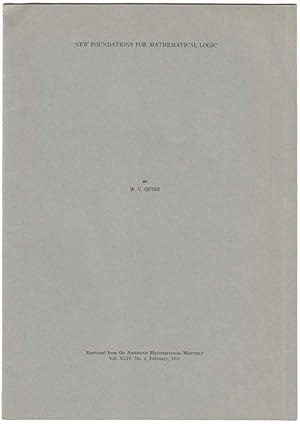About this Item
QUINE S NEW FOUNDATIONS . First edition, the rare offprint issue, of the paper in which Quine first presented his axiom system for set theory (now usually known as NF ). "Although [Quine] is best known to a wider public for his philosophical writings, his most enduring and most concrete legacy for the next 50 years may well turn out to be his most mathematical: he gave us NF" (Forster, p. 838). NF was intended to address the crisis of foundations that mathematicians have attempted to resolve since the early 20th century. "This crisis had many causes and despite the disappearance of the expression from contemporary speech has never really been resolved. One of its many causes was the increasing formalisation of mathematics, which brought with it the realisation that the paradox of the liar could infect even mathematics itself. This appears most simply in the form of Russell s paradox , appropriately in the heart of set theory. At first blush one might think that where sets are concerned any intension has an extension: this is the axiom of na´ve set existence. For any property of sets there exists a set containing precisely the sets with that property, all of those and no others. This leads rapidly to Russell s paradox, the paradox of the class of all sets that are not members of themselves. This is the Russell class. Is it a member of itself? Well, if it is, it isn t, and if it isn t, it is. This is Russell s paradox. The aperšu that leapt to mind was that the problem has something to do with the possibility of sets being members of themselves, or to do with defining sets in terms of membership of themselves. Although these two might sound like formulations of the same insight, they nevertheless lead to radically different resolutions, and to two traditions in set theory represented by Zermelo-Fraenkel set theory (often just called set theory by its votaries, and in any case universally abbreviated to ZF ) and Quine s NF" (ibid., pp. 838-9). No copies of this offprint listed on ABPC/RBH. The first attempt to resolve Russell s and other similar paradoxes was made by Russell himself (1908) in his theory of types. In this theory, every set is assigned a type (a positive whole number); the bottom type is a type of atoms and sets of type n+1 are sets of things of type n. Every variable of the theory is constrained to range over one level only. This means that Russell s paradox cannot even be formulated within type theory. However, the theory was found to have many drawbacks, as it prevented not only the formulation of the troublesome paradoxes, but also other apparently sensible statements. In addition, it necessarily introduces infinite multiplicities: for example, there has to be one empty set of each possible type, as well as a set of natural numbers of each type, etc. NF is similar to Russell s theory in that it involves types, but rather than assign a type to each set once and for all, it assigns a type to each variable in a given formula. If a variable x in a given formula is assigned type n, and if x ? y appears in the formula, then y must be assigned type n+1. In addition, if x = y appears in the formula, then x and y must have the same type. A formula is stratified if there is an assignment of types to variables in the formula that meets these constraints. The axioms of NF are now simply stated: extensionality, together with a scheme that says that the extension of a stratified formula is a stratified formula. NF avoids the paradoxes of naive set theory because the formulas necessary to formulate the paradoxes are not stratified (for example, a set cannot be a member of itself because x ? x is obviously not a stratified formula). But it also avoids the multiplicities and other difficulties inherent in Russell s type theory. The approach taken in ZF is to restrict what objects can be called sets, rather than to impose restrictions on how sets are defined, as is done in NF. In ZF the empty set is a set, an.
Seller Inventory # 2930
Contact seller
Report this item
